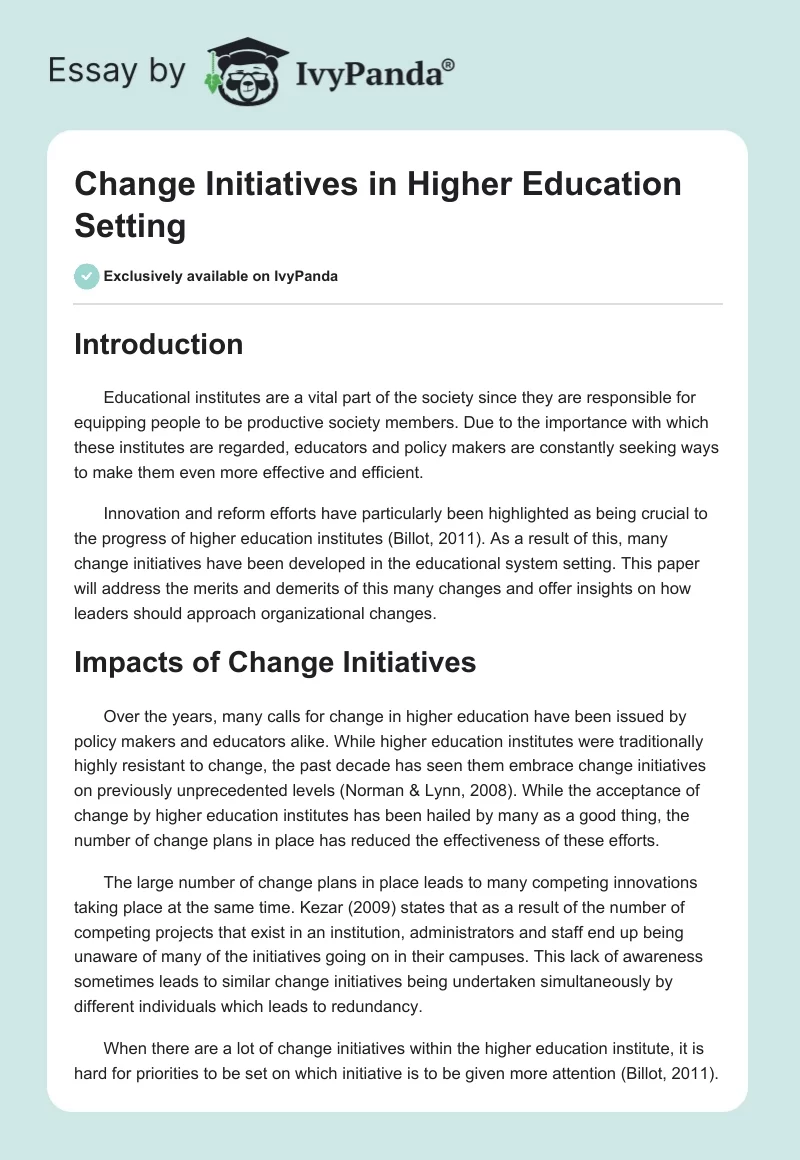Introduction
Educational institutes are a vital part of the society since they are responsible for equipping people to be productive society members. Due to the importance with which these institutes are regarded, educators and policy makers are constantly seeking ways to make them even more effective and efficient.
Innovation and reform efforts have particularly been highlighted as being crucial to the progress of higher education institutes (Billot, 2011). As a result of this, many change initiatives have been developed in the educational system setting. This paper will address the merits and demerits of this many changes and offer insights on how leaders should approach organizational changes.
Impacts of Change Initiatives
Over the years, many calls for change in higher education have been issued by policy makers and educators alike. While higher education institutes were traditionally highly resistant to change, the past decade has seen them embrace change initiatives on previously unprecedented levels (Norman & Lynn, 2008). While the acceptance of change by higher education institutes has been hailed by many as a good thing, the number of change plans in place has reduced the effectiveness of these efforts.
The large number of change plans in place leads to many competing innovations taking place at the same time. Kezar (2009) states that as a result of the number of competing projects that exist in an institution, administrators and staff end up being unaware of many of the initiatives going on in their campuses. This lack of awareness sometimes leads to similar change initiatives being undertaken simultaneously by different individuals which leads to redundancy.
When there are a lot of change initiatives within the higher education institute, it is hard for priorities to be set on which initiative is to be given more attention (Billot, 2011). In addition to this, many change initiatives can result in groups being formed within the campus community with each group advocating for the advancement of its specific interests. These interest groups are detrimental of the campus since they result in strife as well as disunity as the campus is engaged in multiple fragmented efforts.
How Leaders Should Approach Organizational Change
Leaders should ensure that they have the necessary skills to guide the change initiatives they are advocating. Norman and Lynn (2008) assert that change efforts in higher education are predisposed to fail unless they are “carried out in a rigorous, theoretically sound, and professionally reflective manner” (p.113). The leaders who promote specific change initiatives should therefore be committed and skilled and base their efforts on a solid understanding of the process of change.
Leaders should keep track of the various change initiatives going on in their institutes to as to avoid duplicative efforts. Duplicative programs result in wastage of resources and inefficiencies in the specific initiatives.
Combining programs which aim to achieve the same goals will result in greater efficiency as well as higher degrees of success as it will result in cooperation to meet the goals of the initiative. Kezar (2009) asserts that if related efforts were joined, there would be “greater human and financial resources and reduced infrastructure expenses”.
In some cases, the high numbers of change initiatives are unavoidable for the institute. Kezar (2009) suggests that in the case where multiple change initiatives are inevitable, the education institute can benefit from generating a list of the changes in priority order. This will have the advantage of ensuring that all the people see that their interests are given consideration even if they are to be addressed at some future date.
My Insights
Leaders should avoid coming up with change initiative projects on their own and then imposing them on the rest of the people. Instead, leaders should seek to get the support of as many members of the campus as is possible for the change initiatives. Norman and Lynn (2008) reveal that innovations or revisions in school programs have had only about 20% success rate due to the lack of support from key players in the school.
Another important consideration when implementing change is to increase the input of students. Most changes are proposed due to the realization that the current way of doing things is not the most effective. The changes therefore seek to address problems that may face the students so as to achieve positive outcomes.
At the present, while there have been intense endeavors to implement change in campuses, the involvement of students in the initiatives has been lacking. Mitra (2004) observes that many schools struggle to come up with effective change initiatives but very few seek the solutions from the students who are central to the success of the change process.
Conclusion
Changes are important if the improvement of student learning and increased research is to be achieved by our higher education institutes. This paper set out to address the challenges that might arise as a result of numerous change initiatives in our campuses. While changes in educational structures and approaches are advantageous, implementing too many changes might have a deleterious effect.
This paper has advocated for the reduction of the number of changes as well as getting the support of the entire campus and including student voice in change initiatives. This will result in greater success for the change efforts hence lead to the achievement of an effective learning environment in the higher education setting.
References
Billot, J. (2011). The changing research context: implications for leadership. Journal of Higher Education Policy and Management, 33 (1), 37–46.
Kezar, A. (2009). Change in Higher Education: Not Enough, or Too Much? Web.
Mitra, D. (2004). The significance of students: Can increasing “student voice” in schools lead to gains in youth development? Teachers College Record, 106(4), 651–688.
Norman, E. & Lynn, H. (2008). Long-term Strategic Incrementalism: An Approach and a Model for Bringing About Change in Higher Education. Innov High Educ 33(3), 111–124.


